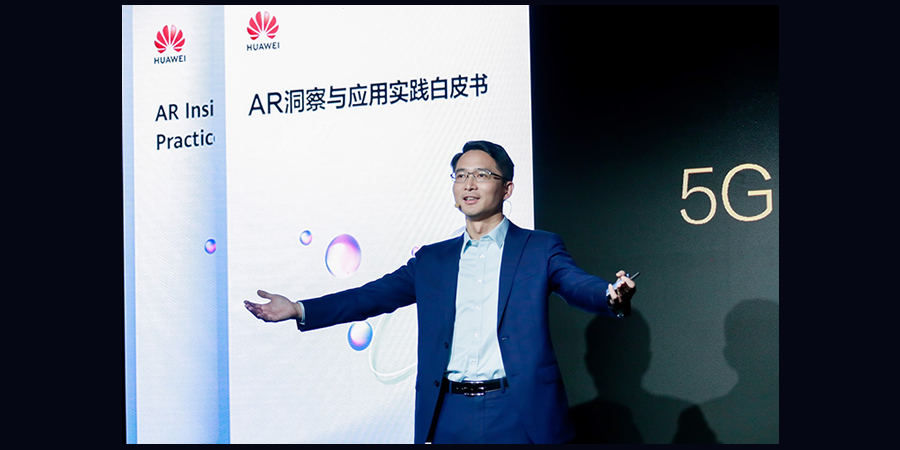Recognizing the potential benefits of 5G technology coupled with immersive technologies such as augmented reality (AR), Bob Cai, Huawei Carrier BG CMO delivered a keynote speech titled 5G + AR, Turning Dreams into Reality at Huawei's Better World Summit for 5G + AR in Shenzhen, China
Highlighting the compatibility and interoperability between the two technologies, Cai said that 5G will switch on AR, and AR will light up 5G. He also announced the release of the AR Insight and Application Practice White Paper, which offers insights into the AR industry in terms of devices, applications, and networking. Cai called on the entire industry to work together for a prosperous 5G + AR ecosystem.
AR creates a new frontier
Huawei and third-party data predict that the AR market will be worth US$300 billion by 2025. "AR will first see massive adoption in five prioritized industries: education, social networking, shopping, traveling & navigation, and gaming," said Cai. "AR can truly enable the convergence of the physical and digital worlds, making dreams a reality."
AR makes communication more efficient
At the event, Cai shared case studies of Huawei employing AR. Due to COVID-19, customers from across the globe are unable to visit Huawei in person, so Huawei makes use of AR to demonstrate its leading products and solutions online, making communication far more efficient. Huawei also uses AR to achieve the quick delivery of 5G base stations, greatly boosting delivery efficiency.
Huawei simplifies AR
Cai demonstrated how Huawei "produces" AR. He explained how Huawei's Air Photo uses unique algorithms to convert a 2D photo into a digital 3D model, considerably simplifying AR 3D character modeling. Cai also introduced Huawei AR Engine, the company's AR development platform oriented toward mobile devices. With Huawei AR Engine, developers need to write only 10 lines of code to create AR effects, hugely increasing the efficiency of AR application development.
When concluding his speech, Cai said, "If you want to go fast, go alone; if you want to go far, go together. The development of AR requires the entire industry to work together and create a prosperous 5G + AR value chain. AR and 5G are combining at the right time. 5G switches on AR, and AR lights up 5G."
As part of the Q&A session, responding to Telecom Review’s question about the use cases of AR, Eric Zhao, vice president of Huawei Carrier Network Business Group (CNBG) Marketing said, “AR is expected to improve and transform every aspect of our life, our work, and our production. AR and 5G combined together will change the way that we learn, we teach, we work, we work out, and we travel.”
He highlighted how Huawei used AR during the pandemic to engage with customers online. “Through the digital channels, we kept introducing our product and solutions as well as the successful experience of other telecom operators to them.” He said how AR was used to demonstrate products and solutions remotely to give a more intuitive experience to customers.
He also stressed on the use of AR to boost the delivery efficiency. “Earlier, to configure a piece of equipment, we had to open a manual and follow every instruction from there which was a very consuming process. Fortunately with the R & D efforts made by our team, we have rolled out an AR aided delivery solution which allows our field engineers to simply use their smartphone to scan a base station and understand how they should insert a board and how they should connect the cables,” he added.
He also explained the ability of AR to demonstrate any form of knowledge in a more intuitive way for faster learning and minimizing the learning curve.
He said AR was transforming shopping experiences and said that just by using a smartphone, shoppers can virtually check the design, colours and size of a certain product before actually buying and bringing it home only to realize that it does not match with home décor.
Many more examples and use cases of AR were discussed and the option of in-depth discussion was left open.
The entire industry should work together to create a 5G + AR ecosystem
A number of high-profile guests attended the event and delivered keynotes, including He Chengjian, director of Shenzhen Communication Management Bureau, David MacQueen, executive director of Strategy Analytics, Huang He, chief producer of Shenzhen TV Station, Wei Rongjie, RealMax CEO, Hiroshi Fukuda, meleap CEO, Liang Jinhao, representative of HADO China Region, and Fu Jie, Executive Director of Shenzhen AR Association. They shared the latest AR use cases and their thoughts about AR's future trends.
According to He Chengjian, Shenzhen is the first city in the world with full 5G SA coverage. ICT services represented by AR can potentially be adopted across a wide range of industries, including industrial production, e-commerce, real estate, home decor, culture, sport, tourism, healthcare, and education. AR applications have become a key engine for digital transformation and will profoundly change production methods and how we live.









